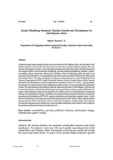Please use this identifier to cite or link to this item:
https://cris.library.msu.ac.zw//handle/11408/641Full metadata record
| DC Field | Value | Language |
|---|---|---|
| dc.contributor.author | Mpofu, Thomas P. Z. | - |
| dc.date.accessioned | 2015-09-09T08:46:41Z | - |
| dc.date.available | 2015-09-09T08:46:41Z | - |
| dc.date.issued | 2013 | - |
| dc.identifier.issn | 1815-9036 | - |
| dc.identifier.uri | http://hdl.handle.net/11408/641 | - |
| dc.description.abstract | Despite the many unique and fascinating tourism attractions in Sub-Saharan Africa, the sub-region is still the least visited in the world. The reasons for the poor performance required an objective analysis. The main objective of this paper, therefore, was to identify and analyze the factors that hinder the full realization of Sub-Saharan Africa’s tourism potential. Specifically, the study analyzed the following variables: location, accessibility, climate, attractions, infrastructure, facilities, services, and the image of the sub-region as an attractive tourist destination. The geographical scope of the study was confined to that part of Africa south of the Sahara Desert. The study was based primarily on secondary data sources. These included the World Tourism Organization (WTO), World Travel and Tourism Council, United Nations World Tourism Barometer, and the Regional Tourism Organisation of Southern Africa (RETOSA). They all compile annual reports as well as world tourism rankings by number of visits, revenue generated and employment created. The major findings of the study were that the weak state of tourism in Sub-Saharan Africa was due to: poor and circuitous connectivity with the major tourist generating countries as well as within the subregion itself; inadequate and poorly developed tourism infrastructure and related facilities; widespread poverty; and a generally poor image. In addition, the study found that droughts and famine, as well as the prevalence of such diseases as HIV/AIDS, malaria, yellow fever and cholera had a negative impact. On the basis of these findings, the study recommends that governments of Sub-Saharan Africa should embrace good governance and the rule of law in order to reverse the sub-region’s negative image. The study also recommends that governments should enter into partnerships with private sector bodies in order to improve the conditions of tourist attractions and infrastructure. | en_US |
| dc.language.iso | en | en_US |
| dc.publisher | Midlands State University | en_US |
| dc.relation.ispartofseries | The Dyke;Vol. 7, No. 2; p.26-42 | - |
| dc.subject | Accessibility, poverty, political violence, destination image, infrastructure, game viewing. | en_US |
| dc.title | Factors hindering sustained tourism growth and development in sub-saharan Africa | en_US |
| dc.type | Article | en_US |
| item.cerifentitytype | Publications | - |
| item.languageiso639-1 | en | - |
| item.grantfulltext | open | - |
| item.openairetype | Article | - |
| item.openairecristype | http://purl.org/coar/resource_type/c_18cf | - |
| item.fulltext | With Fulltext | - |
| Appears in Collections: | Research Papers | |
Page view(s)
54
checked on Apr 20, 2025
Download(s)
12
checked on Apr 20, 2025
Google ScholarTM
Check
Items in MSUIR are protected by copyright, with all rights reserved, unless otherwise indicated.




